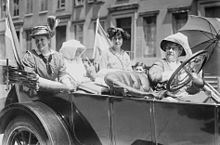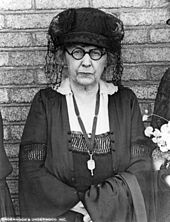Harriot Eaton Stanton Blatch

Harriot Eaton Stanton Blatch (born January 20, 1856 in Seneca Falls , New York , † November 20, 1940 in Greenwich , Connecticut ) was an American suffragette and publicist .
Life
Early years
Harriot Eaton Stanton was born in Seneca Falls, New York and was the sixth of seven children of women's rights activist Elizabeth Cady Stanton and activist Henry Brewster Stanton. She attended Vassar College and received a degree in mathematics in 1878 . Then she spent a year at the Boston School for Oratory , and worked 1880–1881 in Germany as a teacher for girls. On her return trip to the United States , she met English businessman William Henry Blatch, Jr. They married in 1882 and lived in the London area for 20 years . Their first daughter, Nora Stanton Blatch Barney , carried on the family tradition of suffragettes - she was the first American woman to graduate in civil engineering - and was briefly married to Lee De Forest . Harry Blatch died in 1915 from an electric shock that happened to her in an accident.
Harriot Stanton worked with her mother and Susan B. Anthony on the History of Woman Suffrage in 1881 . She wrote an extensive chapter in the second edition setting out the history of the American Woman Suffrage Association , which competed with Stanton and Anthony's National American Woman Suffrage Association . This text helped to unite the two organizations.
In England she carried out statistical studies of the working conditions of English women in rural settings, for which she received a Master of Arts from Vassar College. In a 1901 census, Blatch is listed as a guest in a house belonging to the Haslemere Peasant Arts movement, which promoted craft training for women in the countryside. She also worked in English social reform organizations such as the Women's Local Government Society, the Fabian Society , and the Women's Franchise League. In the Women's Franchise League she developed organizational skills that she later used in America.
Suffrage campaigns
When Blatch returned to the United States in 1902, she sought to renew the stalled suffragist movement in America. She first joined the leadership of the Women's Trade Union League . In 1907 she founded the Equality League of Self-Supporting Women (later renamed the Women's Political Union ) to attract working class women to the suffragist movement. The core of the Equality League was made up of 20,000 workers from the factory, laundry and clothing industries on the Lower East Side of New York City . With the support of this group, she organized and led the 1910 New York Suffragist Parade. Blatch managed to successfully mobilize women from the working class and, at the same time, to continue working with women from the bourgeois equality movement. On the one hand she organized street protests, on the other hand she worked with great diplomatic skill to neutralize the opposition - politicians from the Tammany Hall area who feared women would vote for Prohibition and reject women's suffrage.
The Women's Political Union became a politically significant force and actively campaigned for an amendment to the Constitution in New York State guaranteeing women the right to vote. This was enforced in 1917 after Tammany Hall gave up her resistance. In 1915, Blatch's Women's Political Union merged with Alice Paul and Lucy Burns ' Congressional Union, which later became the National Woman's Party .
War and post-war period
During the First World War , Blatch led the Women's Land Army , which offered other farm work. In 1918 she wrote in Mobilizing Woman Power about the role of women in war and called on women to "go to work". In A Woman's Point of View , published by her in 1920 , she took a pacifist position due to the destruction of the war .
After the passing of the 19th Amendment to the United States Constitution in 1920, Blatch joined the National Woman's Party to seek the passage of an article on equality in the constitution. This was in contradiction to the demands of the Women's Trade Union League, which only sought protective laws for women. She also joined the United States Socialist Party and was nominated for the office of New York City Comptroller and later for the New York State Assembly . However, she did not win the election and did not get a seat. She later resigned from the party because she could not support the approach to protective laws for women. In the 1920s, Blatch also worked on behalf of the League of Nations on drafting treaty articles .
Last years and death
In 1939, Blatch suffered a broken hip and moved to a retirement home in Greenwich, Connecticut . Her memoir, Challenging Years , was published in 1940, a week after her death on Thanksgiving in Greenwich that year .
Publications
- Challenging years: the memoirs of Harriot Stanton Blatch , GP Putnams̓ sons, 1940
- Mobilizing Woman-Power , IndyPublish.com, 2007, ISBN 1-4353-6284-5 , new edition
- A Woman's Point of View: Some Roads to Peace , Kessinger Publishing, 2010, ISBN 1-163-59560-8 , new edition
literature
- Jone Johnson Lewis: Harriot Stanton Blatch . About.com. Retrieved July 19, 2006.
- Ellen Carol DuBois: Harriot Stanton Blatch and the Winning of Woman Suffrage . Yale University Press, 1997, ISBN 0-300-06562-0 .
- Harriot Stanton Blatch, Alma Lutz; Challenging Years: the Memoirs of Harriot Stanton Blatch ; GP Putnam's Sons, New York, NY, 1940.
Web links
Individual evidence
- ↑ Ellen Carol DuBois, "Working Women, Class Relations, and Suffrage Militance: Harriot Stanton Blatch and the New York Woman Suffrage Movement, 1894-1909," Journal of American History, June 1987, Vol. 74 Issue 1, pp 34-58 in JSTOR
- ↑ Mrs. Blatch Dead. Famed suffragist. Leader Here Of Radical Wing of Movement. Champion of Woman's Rights, 84th First To Plan Parades. Associate In England of Sylvia Pankhurst. A Daughter of Elizabeth Cady Stanton . In: New York Times , November 20, 1940. Retrieved July 21, 2010. “Mrs. Harriot Stanton Blatch, former leader of the radical wing of the woman's suffrage movement in the United States and also well ... "
| personal data | |
|---|---|
| SURNAME | Blatch, Harriot Eaton Stanton |
| BRIEF DESCRIPTION | American suffragette and publicist |
| DATE OF BIRTH | January 20, 1856 |
| PLACE OF BIRTH | Seneca Falls , New York |
| DATE OF DEATH | November 20, 1940 |
| Place of death | Greenwich , Connecticut |


